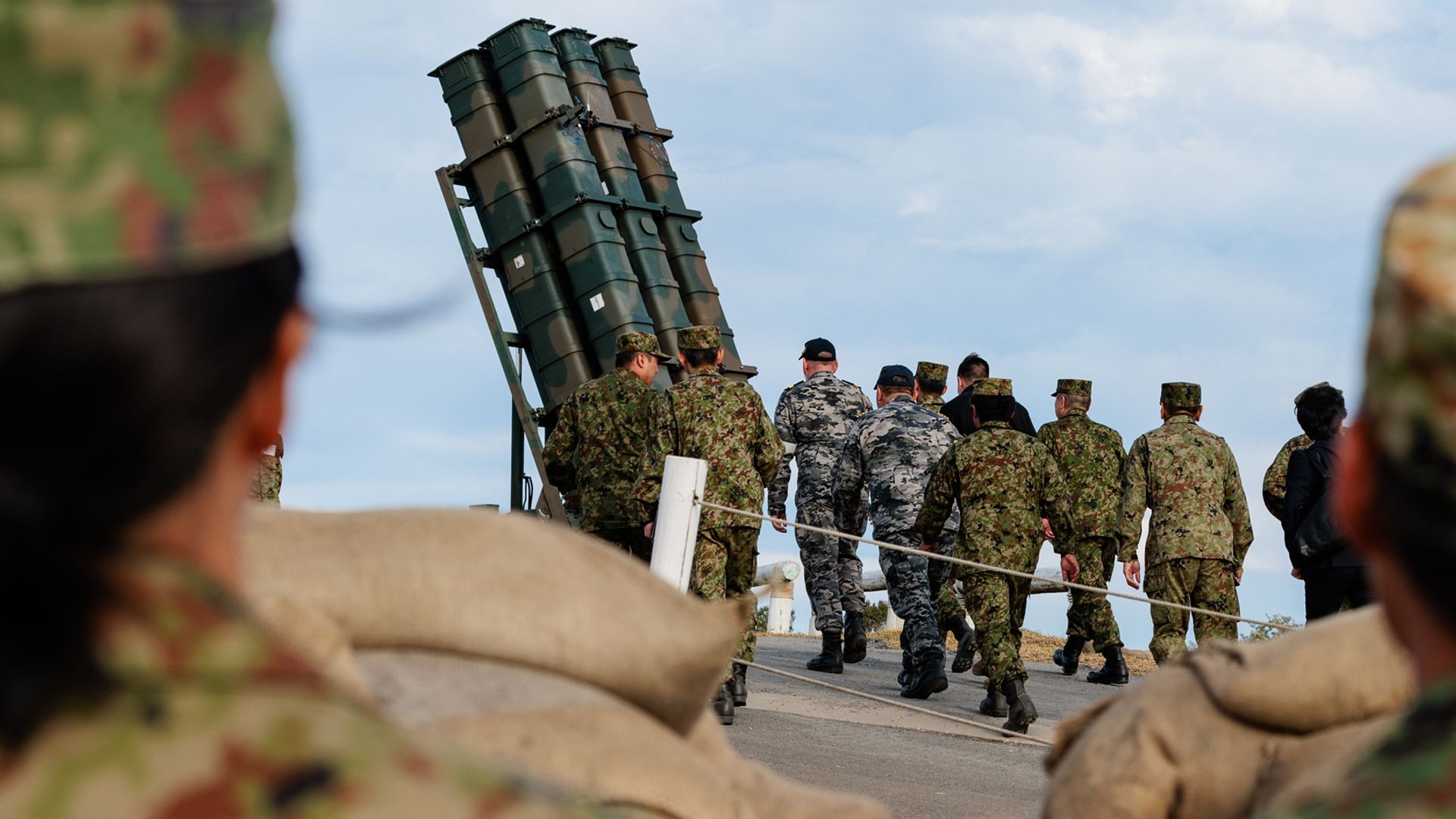
IT JUST GOT A LITTLE BIT HARDER FOR CHINA TO TRY AND TAKE TAIWAN…OR IMPOSE ITS WILL IN THE WESTERN PACIFIC. THAT’S BECAUSE JAPAN JUST MOVED A BATTERY OF ITS NEW TYPE 12 SURFACE TO SHIP MISSILES TO OKINAWA.
MEDIA OUTLETS IN JAPAN SAY THE COUNTRY’S SELF DEFENSE FORCE, THE OFFICIAL NAME OF THE JAPANESE MILITARY, MOVED THE COMPONENTS FOR THE TYPE-12 MISSILE UNIT TO THE ISLAND IN MID MARCH. IT’S THE FIRST TIME THERE’S BEEN AN ANTI-SHIP MISSILE UNIT ON OKINAWA, AND THE TYPE 12 IS CERTAINLY A GREAT WEAPON SYSTEM TO MARK THE OCCASION.
JAPAN TEST FIRED THE NEW TYPE-12 OFF AUSTRALIA’S EAST COAST LAST YEAR DURING TALISMAN SABRE. THE UPGRADED SURFACE-TO-SHIP MISSILE IS LONGER, FEATURES A MODIFIED SHAPE AND BOASTS INCREASED ENGINE ENDURANCE. THE TYPE 12 ALSO GOT AN UPGRADE TO ITS COMMAND LINK–SO IT CAN GET TARGET UPDATES WHILE IN FLIGHT. THAT’S HANDY AGAINST SHIPS, WHICH DON’T EXACTLY SIT STILL WAITING TO BE SUNK.
AND ONE OF THE GREATEST UPGRADES ON THE TYPE 12 IS ITS NEW RANGE. INITIALLY TYPE 12S WERE ONLY EFFECTIVE TO ABOUT 100 KILOMETERS…NOW THEY’RE GOOD TO ABOUT 1000 KILOMETERS…AND THAT’S WHY PUTTING THEM ON OKINAWA MEANS SO MUCH, BECAUSE IT’S A CRITICAL CHOKE-POINT IN WHAT’S KNOWN AS THE FIRST ISLAND CHAIN.
ALRIGHT, SO LET’S GO AHEAD AND BREAK DOWN THAT FIRST ISLAND CHAIN AND TALK ABOUT WHY IT’S SO IMPORTANT. IT STARTS UP HERE IN THE NORTHERN PART OF THE JAPANESE ARCHIPELAGO, AND THEN IT EXTENDS DOWN THROUGH AND INCLUDES TAIWAN, THE PHILIPPINES, INDONESIA, DOWN INTO MALAYSIA. SO BASICALLY, THIS AREA RIGHT HERE IS CONSIDERED THE FIRST ISLAND CHAIN.
WHERE IS OKINAWA IN ALL OF THIS? IT IS RIGHT HERE. RIGHT ABOUT THE MIDDLE. AND HOW FAR, YOU MIGHT ASK YOURSELF, IS OKINAWA FROM MAINLAND CHINA? THAT’S A DISTANCE OF 723 KILOMETERS. 723 KILOMETERS. FOR THOSE OF YOU THAT WERE LISTENING ACUTELY, YOU MIGHT REMEMBER THAT THE TYPE 12 MISSILE HAS A RANGE NOW OF 1,000 KILOMETERS. 1,000 IS MORE THAN 723.
SO, FROM OKINAWA, THE JAPANESE SELF DEFENSE FORCE COULD, IN THEORY, HIT TARGETS WITHIN MAINLAND CHINA. NOW, THESE ARE ANTI SHIP MISSILES. SO, WE DON’T KNOW IF THEY HAVE THE TECHNOLOGY NECESSARILY TO TARGET LAND-BASED OBJECTS. BUT ESSENTIALLY, IT SHOULD HELP DETER THE CHINESE NAVY, THE PEOPLE’S LIBERATION ARMY NAVY, FROM TRYING TO INCUR PAST THE FIRST ISLAND CHAIN.
ALSO, THIS IS A GOOD TIME TO TELL VIEWERS OUT THERE THAT THESE TWO BEAUTIES ARE F35s. THEY JUST LANDED IN BRUNEI, WHICH IS FURTHER PROOF OF THE U.S. STRENGTHENING ALLIANCES IN THE INDO-PACIFIC REGION, INDOPACOM AS IT’S KNOWN, AND SOLIDIFYING ALL OF THE PARTNERSHIPS, MILITARY PARTNERSHIPS, THAT EXIST IN THIS REGION OF THE WORLD. WHERE IS BRUNEI ON THIS MAP? YES. WHERE’S BRUNEI? OH, THANK YOU.
IT IS RIGHT. RIGHT ABOUT THERE. OKAY. SO, IN ADDITION TO THE JAPANESE TYPE 12, WE HAVE THE U.S. AIR FORCE LANDING F-35s IN BRUNEI, WE HAVE THE AIR FORCE AND MARINES IN THE PHILIPPINES. WE HAVE THE JAPANESE PUTTING TYPE 12s ANYWHERE AND EVERYWHERE THEY CAN, WHICH WILL BE OVER THE LENGTH AND BREADTH OF ITS LAND, I’M SURE. AND WE ALSO KNOW THAT THE U.S. MARINE CORPS AND THE AIR FORCE IS GOING TO BE POPULATING MANY OF THESE SMALL LITTLE REMOTE ISLANDS, LITTORAL LOCATIONS, WITH FORCES. “ACE” IS WHAT IT’S CALLED FOR THE AIR FORCE, AGILE COMBAT EMPLOYMENT. THE MARINES USED TO CALL IT FORCE DESIGN 2030. NOW, THEY’VE KIND OF GOTTEN RID OF THE 2030 PART OF IT. BUT ALL OF THAT IS IN ADDITION TO THE 30,000 TROOPS THAT THE U.S. ALREADY HAS STATIONED IN OKINAWA. SO, WHAT THE U.S. HAS DONE WITH THE PARTNERSHIPS THAT IT’S CREATED WITH ITS ALLIES, IS ESSENTIALLY CREATE A STEEL MARITIME CURTAIN ACROSS THIS ENTIRE REGION OF THE FIRST ISLAND CHAIN. AND THEY DO THAT TO KEEP THE PEOPLE’S LIBERATION ARMY NAVY, THAT’S THE OFFICIAL NAME OF THE CHINESE NAVY, LOCKED IN WITHIN THAT FIRST ISLAND CHAIN.
NOW, THE CHINESE NAVY, THE PLAN, HAS THE WORLD’S LARGEST NAVY YES, BUT THAT IS ONLY BY HULL NUMBER. IT IS NOT NECESSARILY BY MASS. AND THE VAST MAJORITY OF THE VESSELS IN THE PLAN ARE NOT BLUEWATER SHIPS. THE CHINESE NAVY IS NOT A BLUEWATER NAVY. WHAT DOES THAT MEAN? THEY CAN’T SAIL IN THE WIDE-OPEN OCEAN LIKE THE U.S. FLEET CAN. LIKE SOME RUSSIAN SHIPS CAN. LIKE SOME IN THE UK, FRANCE, AND INDIA. THEY ALL HAVE SOME BLUE WATER, OPEN OCEAN VESSELS. BUT THE WORLD’S FOREMOST FLEET IN MARITIME OPEN OCEAN NAVIGATION IS, BY FAR AND AWAY, THE UNITED STATES NAVY. AND THE CHINESE NAVY JUST DOESN’T HAVE THE CAPACITY TO COMPETE WITH THE U.S. NAVY OUT HERE. WHICH IS WHY SO MUCH FOCUS IS PUT ON KEEPING THE PLAN LOCKED INTO THAT FIRST ISLAND CHAIN.
ALSO, LET’S TALK ABOUT F-35s A LITTLE BIT MORE. THE F-35 WAS JUST RECENTLY CERTIFIED TO BE ABLE TO CARRY NUCLEAR ARMAMENTS. WE MENTIONED THAT THEY CAN LAND IN BRUNEI, AND LOCKHEED MARTIN AND THE U.S. AIR FORCE JUST GOT DONE TESTING THE ADVANCED RAPID RESPONSE WEAPON. IT’S LOCKHEED MARTIN’S VERSION OF A HYPERSONIC MISSILE. IT WAS PROBABLY THE LAST TEST OF THE WEAPON. IT WAS SUCCESSFUL. THAT’S ABOUT ALL THE DETAILS THAT LOCKHEED MARTIN AND THE AIR FORCE ARE GIVING US ABOUT IT. BUT WHEN YOU PUT ALL OF THIS TOGETHER, THE TYPE 12 MISSILES, THE F-35 LANDING IN BRUNEI, THE SUCCESSFUL TEST OF THE ARRW MISSILE FROM LOCKHEED MARTIN, IT’S ALL BACKING UP THE U.S. STRATEGY OF LOCKING IN THE CHINESE MILITARY INTO THAT FIRST ISLAND CHAIN TO PREVENT IT FROM BEING AGGRESSIVE ON THE OPEN OCEAN, WHERE MORE MARITIME ASSETS MIGHT BE PUT AT RISK.







